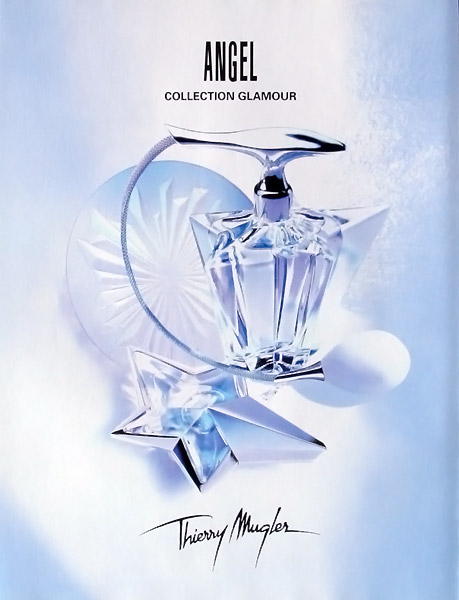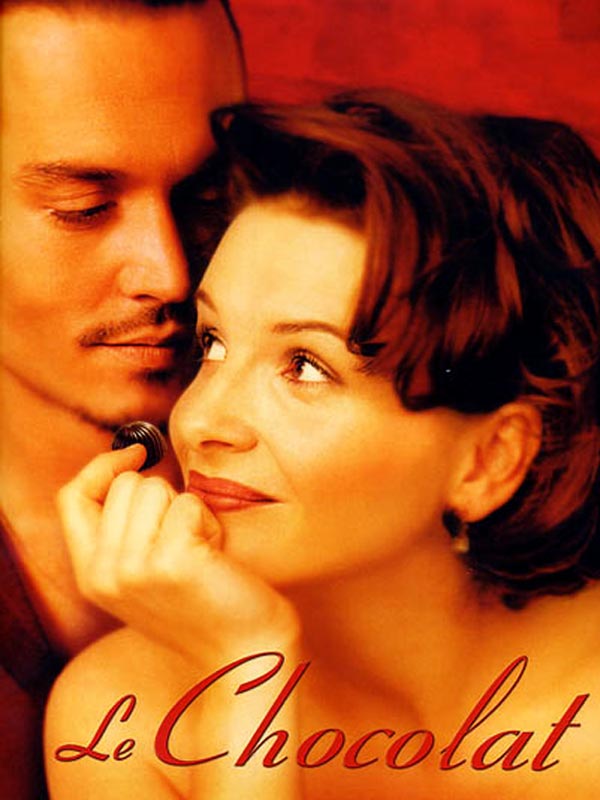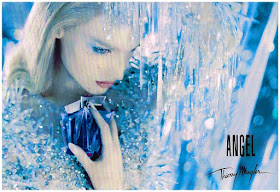Angel (by Thierry Mugler, 1992)
VS.
Chocolat (by Lasse Hallström, 2000)
"Happiness. Simple as a glass of chocolate or tortuous as the heart. Bitter. Sweet. Alive."
(From the book "Chocolat", by Joanne Harris)
In 1992 Olivier Cresp and Yves de Chiris created, for the Maison Thierry Mugler, one of the most discussed, loved and hated fragrance in the history of perfumery: Angel.

Whatever you think, Angel is one of the most iconic perfumes ever made, a scent that influenced many other fragrances, and created thousands of perfume-addicts since the 90s. Smelling a drop of Angel does not leave emotionless: at first the sweetness of the fragrance is so intense to be excessive for a few people.

Volumes have been written about this olfactory masterpiece. We are talking about the gourmand fragrance par excellence, where yellow fruits, marzipan and cotton candy notes explode at first smell, wrapped in a patchouli, woody and intense, to inebriate noses. Patchouli walks together with the fragrance to the base notes, where it is blended with greedy and creamy notes such as honey, vanilla, chocolate and caramel. Base notes are the masterpiece of "Angel": a drydown that bewitched thousands of admirers.

Wearing Angel is similar to sending us back in childhood; it brings back memory of candy stores, without ever being cloying, because patchouli gives an almost masculine cotè, balancing and making the fragrance so sensual. Tasty sweetness and carnal charme, it's like a chocolate melting in the mouth, and releasing all its flavor to satisfy the heart and soul.
Just as "Chocolat", the 2000 movie directed by Lasse Hallström.
The movie narrates the story of Vianne (Juliette Binoche), a fascinating and mysterious woman who open a chocolate shop with her daughter in a small town in Northern France, Lansquenet-sous-Tannes. Thanks to her chocolate, Vianne manages to bring sunrays in the colorless and repressed lives of the the people in the small town.
One day some gypsies drop anchor in the river next to Lansquenet. Among these gypsies, Vianne makes friend with Roux (Johnny Depp) who will leave a mark in her heart. Among the many sequences remained in our hearts, there's one that seems to smell like Angel: the dance between Vianne and Roux on the notes of Caravan.
VIDEO
VIDEO
Vianne slowly indulges in his arms. Faces are approaching, bodies are very close. Viannes's alabaster skin is illuminated by the light of torches. Her hands smell chocolate. His golden skin vibrates sensually. Anouk, Vianne's daughter, is watching them dance and smiles.
The tenderness of childhood that Mugler wanted to evoke with Angel, shines on Anouk's lips.
Angel drives each dance step and every glance between the two dancers. The seductive sweet touch of gourmand notes drives Vianne's moves and the aromatic intensity of the patchouli spreads from Roux's body. The music notes intersect with olfactory ones, and the result is a perfect balance of vibrations descending into the hearts to turn on a flame, and binding the two lovers.
You can't forget a woman like Vianne: strong, free, charming and unconventional. As well as Angel, a heavenly scent that brings to the extreme the gourmand concept, an innovative fragrance that had been able to survive times, fashions, and detractors, as any great olfactive creation. Maybe a few drops of Angel felt in the dough of magic sweets served at La Chocolaterie Maya.

Inside Vianne's chocolates you can find her sparkling soul that has been able to give to others happiness and joy. The same happens with Angel. And if it's true that chocolate is gratifying and so addictive, it's the same for the perfume created by Olivier Cresp and Yves de Chiris more than twenty years ago, a scent that enlightened generations of fans, totally dependent and bewitched by its unique and original jus.

Angel – Thierry Mugler, 1992.
Eau de Parfum
Noses: Olivier Cresp e Yves de Chiris
Family: Oriental Vanilla
The eau de parfum includes notes of Bergamot, Mandarine, Passion Fruit, Peach, Apricot, Marzipan, Cotton Candy, Honey, Patchouli, Vanilla, Chocolate and Caramel

Chocolat (Chocolat), 2000.
Director: Lasse Hallström
Cast: Juliette Binoche, Judi Dench, Alfred Molina, Lena Olin, Johnny Depp, Carrie-Anne Moss, Hugh O'Conor, John Wood, Peter Stormare, Leslie Caron.
Based on the novel Chocolat by Joanne Harris
Music by Rachel Portman
Cinematography by Roger Pratt


Previous chapters:
- Murasaki (Shiseido) VS Dressed to Kill (Brian de Palma)
- White Linen (Estèe Lauder) VS Out of Africa (Sidney Pollack)
---------------------------------------------------
"Angel" by Thierry Mugler
through the years
 |
| Year 1992-1993 |
 |
| Year 1992-1993 |
| Year 1996-1997 |
| Year 1997 |
 |
| Year 2000-2001 |
 |
| Year 2000-2001 |
| Year 2002: 10th Anniversary |
 |
| Year 2004 |
 |
| Year 2004 |
 |
| Year 2006 |
 |
| Year 2006 |
 |
| Year 2008 |
 |
| Year 2012: 20th Anniversary |
| Year 2013 |
 |
| Year 2014 |
-----------------------------(ITALIAN)-------------------------------------------
Angel di Thierry Mugler (1992) vs Chocolat di Lasse Hallström (2000)
"Happiness. Simple as a glass of chocolate or tortuous as the heart. Bitter. Sweet. Alive."
(From the book "Chocolat" by Joanne Harris)
Nel 1992 Olivier Cresp e Yves de Chiris crearono per la Maison Thierry Mugler una delle fragranze più discusse, amate e odiate della storia dell'arte profumiera: Angel. Comunque la pensiate Angel rimane uno dei profumi più iconici mai realizzati, un profumo che ha influenzato moltissime altre fragranze successive e che ha creato centinaia di migliaia di perfumer addicts dagli anni '90 fino a oggi. Annusare una goccia di Angel non lascia mai indifferenti: la prima volta la dolcezza della fragranza è talmente intensa che per alcuni risulta essere eccessiva. Fiumi di parole sono stati scritti su questo capolavoro olfattivo. Stiamo parlando del profumo gourmand par excellence, dove note di frutta gialla, marzapane, e cotton candy esplodono al primo assaggio, avvolte da un patchouli tanto legnoso e intenso da inebriare il naso. Il patchouli accompagna tutta la fragranza fino al fondo dove si mischia a note golosissime e cremose di miele, vaniglia, cioccolata e caramello. Le note di fondo sono il capolavoro di Angel, quel drydown che ha stregato migliaia di estimatori.
Indossare Angel fa tornare bambini, fa ricordare i negozi di dolciumi della nostra infanzia, senza mai essere stucchevole perché il patchouli regala quel cotè quasi maschile che equilibra e rende sensuale la fragranza. Golosa dolcezza e fascino carnale, come un cioccolatino che si scioglie in bocca liberando tutto il suo sapore che appaga il cuore e l'anima. Come Chocolat, film del 2000 diretto da Lasse Hallström. Il film narra la storia di Vianne (Juliette Binoche), donna misteriosa e affascinante che con la figlia apre una cioccolateria in un paesino della Francia del Nord, Lansquenet-sous-Tannes. Grazie al suo cioccolato Vianne riuscirà a portare un raggio di luce nella vita incolore e repressa degli abitanti della piccola cittadina. Un giorno alcuni zingari gettano l'ancora nel fiume vicino a Lansquenet. E tra questi zingari Vianne farà amicizia con uno in particolare, Roux (Johnny Depp) che lascerà un segno nel suo cuore. Tra le tante sequenze rimaste anche nel nostro cuore ce ne è una che sembra profumare di Angel: il ballo tra Vianne e Roux sulle note di Caravan.
E' sera. La festa organizzata da Vianne è finita e il dessert al cioccolato è stato consumato sulla barca di Roux. Gli ultimi invitati ormai sazi si stanno rilassando sugli accordi di musiche gitane. Lei sta raccogliendo i piatti quando Roux la invita per un ultimo ballo. Vianne è incerta, ma accetta. Il suono delle chitarre accompagnano languidamente i passi di danza, dapprima incerti poi sempre più sciolti. Vianne piano piano si abbandona tra le braccia di Roux. I visi si avvicinano, i corpi si sfiorano. La pelle di alabastro di Vianne è illuminata dalla luce delle torce accese. Lei ha le mani che sanno di cioccolata. La pelle dorata di lui vibra di sensualità. Anouk, la bimba di Vianne, li guarda ballare e sorride. La tenerezza dell'infanzia che Mugler aveva desiderato evocare con Angel risplende sulle labbra di Anouk. Angel accompagna ogni passo di danza e ogni sguardo tra i due ballerini. La golosità seduttiva delle note gourmand guida le movenze di Vianne e l'intensità aromatica del patchouli emana dal corpo di Roux. Le note musicali si intrecciano alle note olfattive e il risultato è un perfetto equilibrio di vibrazioni che scendono nei cuori per accendere la fiamma e suggellare l'unione tra i due innamorati.
Vianne è una donna che non si dimentica facilmente: forte, libera, affascinante e anticonformista. Così come Angel, un profumo celestiale che ha portato all'estremo il concetto di gourmand, un profumo innovativo che come le ogni grande creazione olfattiva ha saputo sopravvivere al tempo, alle mode e ai detrattori. Forse qualche goccia di Angel è caduta nell'impasto dei magici dolci serviti a La Chocolaterie Maya. Nei cioccolatini di Vianne si può trovare l'anima scintillante della sua creatrice che ha saputo donare agli altri felicità e gioia. Così è per Angel e se è vero che il cioccolato gratifica e dà dipendenza anche il profumo creato da Olivier Cresp e Yves de Chiris oltre vent'anni fa ha illuminato intere generazioni di appassionati totalmente dipendenti e stregati dal suo jus unico e originale.
Angel – Thierry Mugler 1992
Eau de Parfume
Naso: Olivier Cresp e Yves de Chiris
Famiglia: Vaniglia Orientale
Il profumo racchiude note di bergamotto, mandarino, pesca, albicocca, frutto della passione, marzapane, cotton candy, miele, patchouli, vaniglia, cioccolato, caramello
Chocolat (Chocolat) – 2000
Regia: Lasse Hallström
Cast: Juliette Binoche, Judi Dench, Alfred Molina, Lena Olin, Johnny Depp, Carrie-Anne Moss, Hugh O'Conor, John Wood, Peter Stormare, Leslie Caron.
Ispirato al romanzo Chocolat di Joanne Harris
Musica di Rachel Portman
Fotografia di Roger Pratt






































